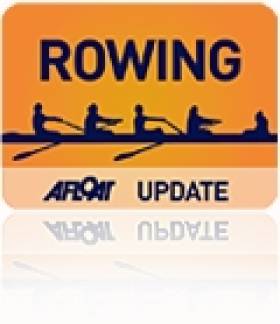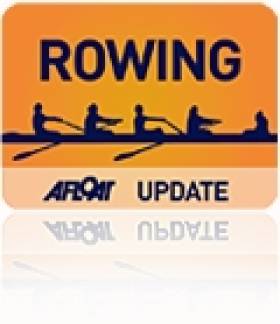Displaying items by tag: Dublin Sculling Ladder
Beggan Best at Dublin Sculling Ladder Time Trial
#Rowing: Niall Beggan of Commercial won the time trial for the Dublin Sculling Ladder at Islandbridge today. His time of six minutes 53.87 seconds was over two seconds clear of his Commercial clubman, Mikey Campion, who was second. Beggan had also won in 2017. The fastest woman was Aoife Moloney, also of Commercial, with Neptune’s Claire Feerick second.
Hughes Climbs to Top of Dublin Sculling Ladder
#Rowing: Turlough Hughes won the Dublin Sculling Ladder Time Trial. The Dublin University Boat Club man had just under a second to spare over Niall Beggan of Commercial on Saturday. One of the masters of the event, multiple winner Sean Jacob of Old Collegians, took third. The top junior was Ronan Brennan of Neptune, who finished a remarkable fourth overall. Many of the Commercial scullers wore Beggan’s picture on their tops.
The fastest woman was Hazel O’Neill of Commercial – her closest rival was Neptune’s Claire Feerick. Commercial’s Alison Daly was the third overall of the women competing and the fastest junior woman, heading up a strong Commercial showing in this discipline.
Dublin Sculling Ladder Time Trial, Islandbridge, Saturday (Selected Results)
Men
1 T Hughes (Trinity) 6 minutes 31.67 secs (Overall Winner), 2 N Beggan (Commercial) 6:32.65, 3 S Jacob (Old Collegians) 6:40.85; 4 R Brennan (Neptune) 6:41.66 (Fastest Junior)
Women
1 H O’Neill (Commercial) 7:23.47 (Fastest Woman), 2 C Feerick (Neptune) 7:24.6, 3 A Daly (Commercial) Fastest Junior Woman.
Neale In Control at Dublin Sculling Ladder Time Trial
# Rowing: Dave Neale of Old Collegians was the fastest sculler at the Dublin Sculling Ladder time trial on the Liffey on Saturday. The Offaly man had just under six seconds to spare over clubmate Sean Jacob, another former winner. Niall Beggan of Commercial was the fastest junior, and placed 12th overall. Hazel O’Neill of Trinity won the yew goblet for being the top woman, and again a junior placed very well: Neptune’s Claire Feerick was just eight places and less than seven seconds behind O’Neill.
Dublin Sculling Ladder Time Trial, Islandbridge (Selected Results)
Men: 1 D Neale 6 min 15.10 seconds, 2 S Jacob 6:21.09, 3 D Kelly 6:28.51, 4 G DeVita 6:29.33, 5 C Dowling 6:33.50, 6 M Bailey 6:33.93. Junior: N Beggan 6:40.79. NJ: R Quinn 6:57.35.
Women: 1 H O’Neill 7:10.78, 2 B Quinn 7:22.79, 3 J Ryan 7:24.46. Junior: C Feerick 7:17.65. NJ: K O’Connor 7:50.69.
Neale and Morris Fastest at Dublin Sculling Time Trial
#ROWING: Dave Neale edged out Old Collegians clubmate Seán Jacob by less than half a second to win the Dublin Sculling Ladder time trial at Islandbridge on Saturday. The Offaly man was winning his third DSL time trial, in the 49th staging of the event. Ruth Morris, a lightweight, was an impressive winner of the women’s event: she set a time just over 51 seconds off Neale’s winning one. It was her first time to win.
Dublin Sculling Ladder time trial, Islandbridge, Saturday (Selected Results, provisional)
Men
Senior: 1 D Neale (Old Collegians BC) 6 mins 48.22 secs, 2 S Jacob (Old Collegians) 6:48.36, 3 T Hughes (UCD) 6:52.03, 4 A Maher (Commercial) 7:01.31, 5 A Griffin (UCD) 7:12.37, 6 F Groome (Commercial) 7:14.15. Junior: S Mulvaney (UCD) 7:16.54.
Women
Senior: 1 R Morris (Trinity) 7:39.56, 2 B Quinn (Three Castles) 8:01.17, 3 E Lambe (Commercial) 8:05.03. Junior: Lambe 8:05.03.
Neale and Bulman Fastest Scullers at Dublin Time Trial
# ROWING: Dave Neale of UCD won the time trial of the Dublin Sculling Ladder at Islandbridge on Saturday. The Offalyman, who also won the Tullamore Time Trial last weekend, headed up the list of 180 contestants with a time of six minutes 51.82 seconds. Albert Maher of Commercial was second and the best junior of the day, Andrew Griffin of UCD came in an impressive third.
The best junior woman, Sally O’Brien of Trinity, also excelled – she was less than three seconds slower than women’s open winner, Amy Bulman of UCD.
Dublin Sculling Ladder Time Trial, Saturday, Islandbridge
Overall: 1 D Neale (UCD) 6 mins 51.82 seconds, 2 A Maher (Commercial) 7:01.58, 3 A Grffin (UCD) 7:14.10, 4 M Bailey (UCD) 7:15.9, 5 P Hughes (Trinity) 7:16.72, 6 P Flaherty (Trinity) 7:19.99.
Men - Open: 1 Neale 6:51.92, 2 Maher 7:01.58, 3 Bailey 7:15.9, 4 Hughes 7:16.72, 5 Flaherty 7:19.99, 6 C Dowling (Commercial) 7:20.51. Junior: 1 Griffin 7:14.10, 2 S Mulvaney (Neptune) 7:40.61, 3 C Flynn (Neptune) 7:44.85.
Women – Open: 1 A Bulman (UCD) 8:09.11, 2 S Foreman (Old Collegians) 8:12.18, 3 G Foley (Commercial) 8:22.97. Junior: 1 S O’Brien (Trinity) 8:11.71, 2 A Rodger (Commercial) 8:28.13, 3 P Mulligan (Portora) 8:32.16.


























